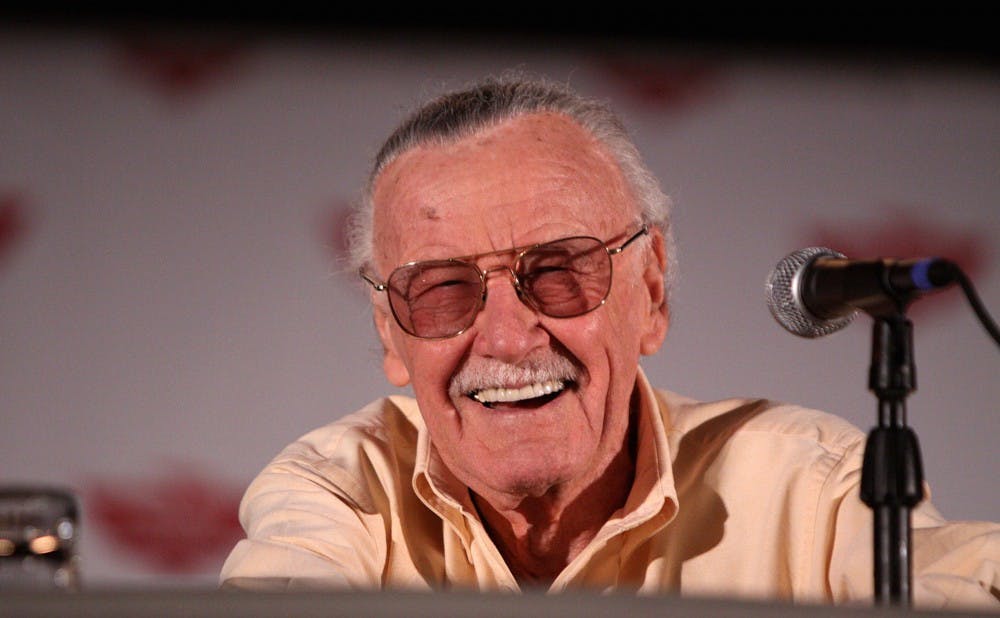When I was young, I was obsessed with my dad’s action figures.
He had worked at a comic book store during graduate school, and the memorabilia he collected during his employment now covered nearly every flat surface in our spare room, where I would sit on the floor playing with the Spidermans and Silver Surfers. For the most part, I created my own adventures for the characters, often partnering random characters together well over a decade before “Avengers: Infinity War” stole my idea for an Iron Man and Doctor Strange team-up, but eventually, I asked my dad about their real origin stories. As he explained the characters to me, I realized that he was referencing one name with impossible frequency — Stan Lee. How one man could have created so many of heroes was beyond me as a child. Even today, I find myself marveling at Lee’s imagination and how it changed not just the comic book industry but all of media.
Marvel Comics has become synonymous with enormity, constantly building bigger and more lucrative franchises with its larger-than-life characters, but before it was the multimedia powerhouse it is today, the company was merely a small chapter of a publishing house. Although it had found some success with Jack Kirby’s Captain America and other characters, Marvel’s expansion and eventual domination of the industry would not come until comic book writer Stan Lee was tapped to create a superhero team to compete with DC’s Justice League. This desperate attempt to revitalize a struggling comic book company denoted a drastic shift in the medium as it pivoted away from the glossy adventures of the Justice League and plunged headlong into the complex, unpolished lives of Stan Lee’s superheroes.
In the context of the Marvel Cinematic Universe — a wildly successful experiment in film serialization — Stan Lee’s true impact on Marvel can become buried under the graphic grandeur of the film franchise and his invariably goofy cameo in each movie. Stripping away the top-shelf special effects and smart screenplays reveals the true core of Marvel: its characters. Their cool powers are secondary to their fascinating personalities and rich inner lives, particularly Spider-Man, arguably Marvel’s most popular character. The allure of Spider-Man was never really the hero himself: it was always Peter Parker, the sweet, geeky and painfully human kid whom Lee lovingly crafted to be something of a foil to the infallible Superman. This dynamic has carried over into superhero stories as a whole, prompting comic books, movies and television shows to pull back the masks and explore what happens when the battles are over.
You could argue that it is the weird inventiveness of the characters themselves that ensured their longevity. After all, who could forget a mild-mannered scientist who can transform into a bright green, shorts-sporting beast and only spout monosyllabic gibberish as he smashes up buildings? In the hands of another creator, though, the Incredible Hulk would have been just that: a blandly remarkable superhero with a cool power and a far more interesting rogue gallery.
Lee, however, devotes time and care to crafting Bruce Banner, establishing his explosive temper to make the Hulk a metaphorical manifestation of Banner’s anger rather than a basic power. His work is literary in nature, expanding beyond simple set-dressing for caped crusaders doing battle to explore character motivations and relationships. Comic books are often regarded as some of the lowest forms of entertainment, but Lee’s stories defy the pulpy, ad-driven purpose of early comics. They serve a function beyond shallow amusement, using the powerful marriage of prose and graphic image to convey important messages. After all, Lee was one of the creators of Black Panther, the first mainstream African-American superhero: he knew that comic books had the ability to influence society and did not shy away from using his position as creative leader at Marvel for advancing social progress.
Stan Lee’s cultural ubiquity over the last few decades makes it difficult to believe that he is truly gone. His death came as a shock to a world of fans who felt that Lee was as impenetrable as his super-powered characters. But in spite of his passing, he will continue to live on as a bona fide legend. Lee’s work has endured even as the cultural landscape has undergone countless revamps, a permanent fixture of media and storytelling as we know it. Even after the Marvel Cinematic Universe inevitably rolls its final post-credits scene and more comic book arcs wind to a close, people will never forget Lee’s characters and their deeply inviting humanity.
Get The Chronicle straight to your inbox
Signup for our weekly newsletter. Cancel at any time.

